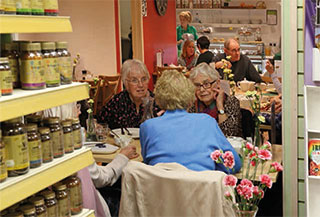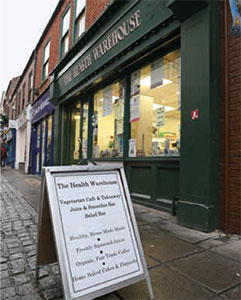When all else fails, try something...

Like everyone else, out-of-town shopping and the Internet have conspired to hit Darlington’s The Health Warehouse hard. But while others despair, Mike Barker looks for the opportunities...
The challenges facing independent health food shops are well known. We struggled against competition from supermarkets for many years. Our response was to reduce our reliance on food and to focus instead on supplements.
But in the past decade, the growth of the internet and the ability of on-line shops to offer a seemingly unlimited range of supplements at prices we cannot match, at a time when retailing in general has been in economic recession, has hit us all where it hurts most. In our pockets.
During the past few years, within 12 miles of my shop, independent health food stores have closed down in Darlington, Bishop Auckland, Stockton, Middlesbrough, Barnard Castle, Norton and Saltburn. Even Newcastle now has just one small independent left.
Some of the biggest and best known health stores around the country have closed their doors for the final time.
Maybe in the more affluent, cosmopolitan areas of the country, independent health shops are thriving, but across my region it’s a real struggle to survive – and most haven’t.
Remember the good times?

It was so different when we started. Thirty years ago, wandering around Darlington town centre one day, I saw workmen nailing To Let signs above a run of four shuttered units round the back of the Indoor Market, looking out on to the Market Place. They were each around 650 square feet in size and had previously been used as storage units for market traders.
I applied to rent one of the units and four months later, a week before Christmas 1985, The Health Warehouse opened for business.
There were already two small health shops in the town centre, and a wholefood co-operative. But none of them, it seemed to me, were up to date with modern retailing techniques. They were dingy and poorly merchandised and none of them sold fresh food or takeaway items.
My new shop was across the road from the Town Hall and the Dolphin Centre, the main sports centre in town. Twice a week the outdoor market was right outside our front door. There were thousands of people on my doorstep who might be looking for a fresh, healthy takeaway lunch.
While I built conventional shelving in most of the shop area, selling whole foods and supplements, I installed a small serve-over fridge and some bread shelves at the front of the shop, found some local bakeries to supply me and cobbled together a takeaway menu.
Within a month I had reached the turnover target I had set for the second year. My sales continued to rise, month by month, year by year.
Times have changed
Thirty years ago, Darlington town centre still boasted a choice of independent butchers, fishmongers and delicatessens scattered among the clothes shops and electrical retailers.
Binns had a magnificent wood-panelled food hall where the heady smell of fresh ground coffee mingled with the warmth of fresh bread. The centre of the hall was filled with an oval-shaped refrigerated display of cooked meats, cheeses, pates and salads. Across the High Row, the Victorian splendour of the indoor market was crammed with shoppers buying from dozens of fresh food stalls.
Nowadays, Binns sells televisions in its old food hall, the market has a majority of non-food stalls and most of the independent shops in the town have gone.
At the same time, the town has welcomed new supermarkets: Asda, Aldi and Lidl have arrived, Sainsburys has tripled in size and opened a string of neighbourhood stores, Morrisons has opened two huge new stores. Tesco is circling.
Read the rest of this Business Development feature here.